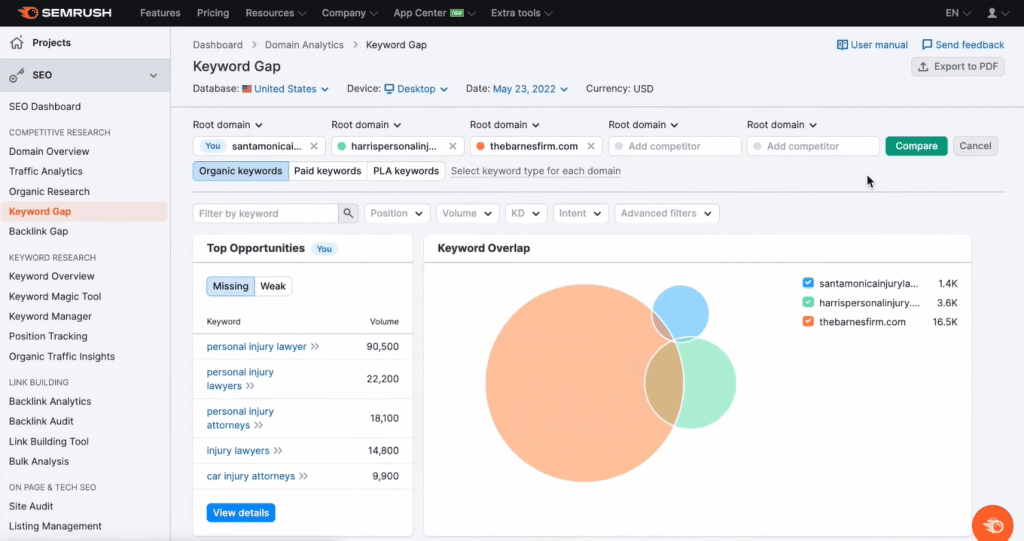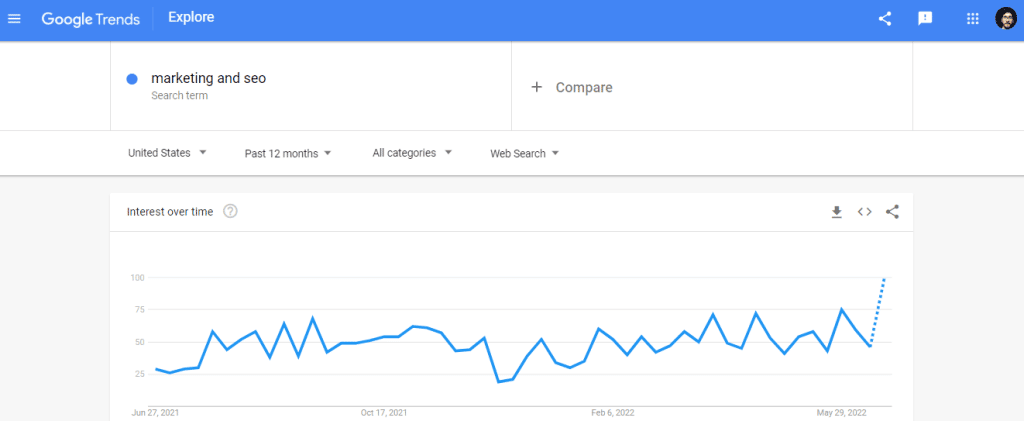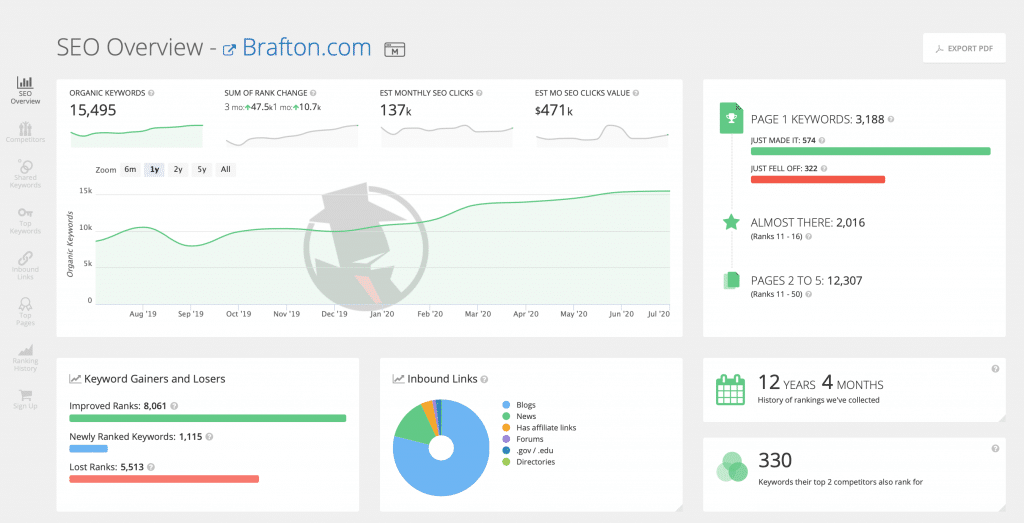When you have a question, and the people around you can’t answer it, what is your favorite source of information?
If you answered Google or any other internet search engine, be it Bing, Yahoo!, YouTube, know that you are accompanied by a large portion of the world population.
In this scenario, SEM (Search Engine Marketing), a set of techniques that aims to use these engines for promotion on the Internet, emerges.
In this article, we will explain the following points:
Download this post by entering your email below
What is SEM?
SEM (Search Engine Marketing) can be described as any marketing strategy based on search engines. Such a strategy can be used to spread business online or offline and promote actions that happen virtually or physically.
SEM is divided into two parts.
One is SEO, which aims to generate more organic traffic for a particular domain. And the other is the investment in sponsored links.
We are talking about the ads that are displayed on Google and other platforms. These materials involve strategies such as keyword searches and other techniques that are shared with SEO.
But they also involve the analysis of public segmentation and strategies more closely aligned with the purchase of traditional advertising media.
In short, SEM can be described as a kind of umbrella. Under it are inserted the SEO and other techniques that help the company be visible and well-positioned in major search engines.
A Digital Marketing strategy will only be complete and well-developed if a quality investment and effort use both dimensions.
Learn a little more about them below.
SEO — Search Engine Optimization
SEO, or Search Engine Optimization, gathers the strategies that involve the optimization of sites, blogs, and pages to rank well in search engines and, consequently, attract more visitors.
To make all this possible, SEO counts on a great ally: Content Marketing, which is based on creating relevant content pages for the buyer persona.
Thus, in addition to optimizations for search engines, which involve aspects of site structure, scannability, use of keywords, responsiveness, loading speed, and others, it is also necessary to produce text or other types of valuable materials.
It is worth mentioning that the investment in SEO techniques is critical, as studies show that 90% of people click on only one link among the results of their searches.
Other user behavior studies have also found that the first position in Google captures about one-third of clicks made in SERPs.
Let’s give an example: suppose you are working on the keyword “Content Marketing” in your strategy, and that this keyword has about 8,000 monthly searches.
One-third of this number, or approximately 2,666 clicks, will go to the page ranking first on Google. The rest of the clicks will be divided among the other results, with the first result having the overwhelming majority of total clicks.
Sponsored links — Paid media
Sponsored links are advertisements, i.e., they are part of a paid media tool. You have probably already performed a search and come across some ad results.
In Google, for example, they usually come before the organic results and in the sidebar.
To use this strategy, you must register on an ad platform, such as Google Ads or Bing Ads, and insert the card’s details on which the values will be debited.
This strategy generally charges per click, but more advanced techniques allow the optimization for conversions (sales) or impressions (ad views).
The system used to define which ad will be displayed works in the following way: each time a user searches for the advertised search term, Google will perform an auction.
Thus, it is necessary to define the maximum values you are willing to pay, considering factors such as competition and keyword relevance.
How an Ad Auction Works
Pay-per-click ads are a huge part of any well-rounded SEM campaign. But getting your ads featured via major platform options like Google Ads is about more than simply slapping an ad together and hitting submit.
Every sponsored result you see on a particular SERP underwent an auction process before Google started serving it up to its users.
Here’s a quick look at how that process works.
Pick your keywords
As with anything to do with SEM or improving search rankings, paid ads revolve around keywords.
However, you’ll need to not only choose your keywords but bid on the ones you want to target. Naturally, higher bids have a better chance of winning.
Make quality a priority
Keep in mind that Google is in the business of delivering the best, most accurate search results out there in response to their queries, so it’s not enough to place a nice, meaty bid on the keywords you’re targeting.
Both your ads and the landing pages they point to need to deliver quality user experiences, as well.
Understand quality scores
Google assigns every paid ad that its users create a quality score from 1 to 10, and it’s ultimately that score that determines whether it will appear on a particular SERP.
Naturally, quality scores encompass both your bid and your ad quality. However, the quality and relevance of your landing page is also a factor.
In other words, winning an ad auction on Google Ads or anywhere else is definitely about being willing to place a decent bid on the keywords you want.
But quality counts for more than you think, so even marketers without deep pockets stand a great chance of showing up on key SERPs.
Why is SEM important?
There is no doubt that search engines make up a considerable portion of all traffic generated on the Internet.
To give you an idea, 2.3 million searches are performed on Google every second. Thus, it is easy to imagine the potential of this tool when talking about business.
Search engines are, above all, information platforms and, as such, serve as a foundation for users’ questions.
Therefore, they encourage creating content on the web, bringing as much knowledge as possible to the Internet user.
On the other hand, being the largest online advertising platform in the world, Google is also recognized for its effective business model, which aims to generate profitability for the company’s continuous searches and offer a good user experience.
How to do Search Engine Marketing?
Some practices are recommended in Search Engine Marketing strategies. Below, you can check a few of them.
Using sponsored links
To elaborate a good sponsored links strategy, you will need to start with a good analysis of your product or your brand. One of the significant advantages of internet ads is the fact that they allow detailed public targeting.
So, you should know well who you want to talk to. The ideal is to think about your buyer persona when setting up your ad in Google Ads or other ad platforms.
From there, you will be able to elaborate an efficient communication strategy for that audience.
Sponsored links allow you to run campaigns for a very low cost. So, if you don’t have a robust budget yet, start with campaigns involving a small investment and go on testing what brings the best results.
Using SEO
SEO consists of two dimensions, called On-Page and Off-Page. See below what each one means.
On-Page SEO
Here we are talking about all the techniques that you apply within your own website or your page.
The production of quality content, a fast and optimized site for various platforms, the meta description of your post, and the URL you use are some examples of these actions.
Off-page SEO
Off-Page SEO includes all the techniques that have to do with your site’s connection with the entire internet environment.
These actions are performed outside the website itself. See some examples:
- Link building: establishing a network of internal links between the pages of your site improves the ranking because Google will read all pages as one thing.
- Guest posts: in this strategy, you publish content on blogs and websites of other companies, to strengthen both domains;
- Campaigns and partnership actions: as with guest posts, the goal is to strengthen both domains. In these actions, you can launch rich materials in partnership with the other brand or develop cross-media actions.
So, for you to succeed with your strategy, it is worth following some good practices, like:
- Use the concept of long-tail, that is, specific keywords. Very specific search terms tend to have a low volume of searches and competition.
- Never take advantage of non-recommended techniques, the so-called Black Hat. That is, practices of repeating keywords, titles that do not match the content, etc.
- Analyze data collected by Google Analytics regularly and make changes to your articles, posts, and ads.
- Do not forget to use calls-to-action in SEO strategies. A good CTA can be the difference between the success and failure of your campaign.
- Observe the competition and look for keywords in both sponsored links and organic strategies. Often, you may discover relevant terms in which you can beat your opponents.
- Always put the user first and try to solve their problems. Remember: SEM strategies should always benefit the user.
How to Create an SEM Marketing Strategy
Ready to put together a winning SEM strategy of your own?
Here’s a closer look at some expert tips and best practices to get you started.
1. Understand how your customers search
It’s a given that many members of your target audience will be out there looking for information on the types of products and services you sell.
But a winning SEM strategy digs deeper than that.
For example, consumers who are still at the beginning of their buyer’s journey will likely be looking for basic information about a particular pain point or problem your product or service is designed to resolve.
And customers who have already purchased your product (or something similar) may need maintenance tips or information about compatible items.
Considering all the different ways your audience uses Google to search for information can help you put together a more comprehensive campaign that really gets results.
2. Determine your budget
Careful budgeting is crucial when it comes to any aspect of running your budget, and this is just as much the case when putting together an SEM strategy.
It’s easier than you think to overspend. Make sure your SEM marketing budget includes adequate resources for options like the following:
- Creating high-quality landing pages
- Writing both on-page and advertising copy
- Thorough market and keyword research
- Actual CPC (cost per click)
- Management of live campaigns
- Data and results analysis
3. Make your site user-friendly
Ultimately, it won’t matter how robust your Google Ads budget is or how high your bids are if you’re not pointing people toward a site worth visiting.
Google is only interested in sending people to websites that are not only relevant but that offer a stellar user experience.
So before you invest in the paid ad portion of your SEM strategy, ensure everything’s as it should be with your website and landing pages.
For best results, your site should be:
- Fast, preferably with page load times under two seconds.
- Mobile-friendly and responsive.
- Fully search engine optimized.
- Organized and easy to navigate.
- Frequently updated with high-quality content.
- Clean, simple, and free of clutter.
Efficient, high-quality websites help send your Google quality score soaring and help your paid ads perform well even if you don’t always have the highest bid.
4. Choose highly relevant keywords
Ads that yield a high return on your original investment have certain qualities in common.
They include highly targeted keywords, are data-based, and feature snappy keyword-rich copy.
The more relevant and well-targeted your keywords, the more likely you are to win ad auctions for lower prices.
This is because relevancy drives your quality score way up and can help give you the competitive edge. For best results, do your homework on your keyword options.
Remember, good picks positively nail user intent. Always analyze your choices for factors like competitive density and search volume, as well.
5. Create relevant Ad Groups
Keep in mind that different members of your existing and potential audience will be looking for different things, especially if they’re at differing stages of their collective buyer’s journey.
A good SEM strategy addresses all of these different needs and will call for a variety of different ads.
Google’s Ad Groups feature makes it easy to keep all of your efforts organized. Make good use of them as you apply various strategies to your customer groups.
Be sure to test different messaging options with each audience, as well. Sometimes the simplest changes turn out to be real game-changers.
6. Incorporate negative keywords into your strategy
Truly savvy SEM strategies don’t just focus on prime keywords you do want to be associated with your business, website, and products.
You need to consider which options you don’t want to be linked to your brand, as well.
Negative keywords are an effective way to ensure your ads don’t accidentally show up in response to inappropriate searches, as they prevent them from displaying when they shouldn’t.
Good negative keywords are search terms people are likely to enter alongside your targeted keywords, but that totally change the intent of the search.
For example, if you’re targeting the key phrase “pet grooming” because you run a brick-and-mortar grooming facility, you probably don’t want to appear in searches for “pet grooming ebooks.”
7. Keep an eye on performance over time
Long-term SEM success isn’t about setting up a terrific ad once and then forgetting about it.
You need to keep an eye on its performance over time to ensure it remains relevant. This helps keep your quality score nice and high while your costs stay low.
Factors to consider include:
- Keyword Relevance: Are people clicking on your ad when it appears in searches? If not, the ad may not be an ideal fit for that term.
- Click-through Rate: How many of your ad’s impressions actually attract clicks?
- Landing Page Quality: If people aren’t sticking around on your page once they get there or responding to your call to action, Google may question your page quality.
- Performance History: How well is the ad performing over time?
Remember, lower quality scores often result in higher spending when it comes to your ads, so ensuring your ads remain relevant and effective over time is a must.
Best SEM Tools
Fantastic tools make just about every aspect of running a streamlined marketing campaign more accessible, and this is just as much the case for SEM.
Here are a few incredible SEM tools to take a second look at.
SEMRush

Tasks like keyword research, traffic analysis, and site audits can be time-consuming and complicated, especially for larger companies or big websites that see a lot of traffic.
SEMRush was designed to take the guesswork out of all those things and more.
You can also use SEMRush to figure out who your biggest search competition is, as well as monitor the details of their campaigns. This makes it easy to stay ahead.
Google Trends

Since most SEM campaigns are focused mostly or entirely on ranking better with Google, it makes sense to include at least one Google tool in your strategy.
Google Trends is a great way to stay on top of what’s trending at any given time.
You can see at a glance which options are rising and declining in popularity, so you know which key terms are the best potential investments.
You can also use Google Trends to determine which geographic locations show the highest concentration of people interested in what you’re selling.
SpyFu

Knowing what your competitors are doing to succeed with SEM is a crucial part of succeeding yourself, and SpyFu really takes the guesswork out of doing that.
All you need to do is input a domain — whether yours or someone else’s.
SpyFu will show you which keywords the business attached to that domain has been bidding on.
You’ll see at a glance which ones they’ve ranked for, as well as any variations on those keywords they’ve used over the prior 12 years.
Wrap Up
The application of all these SEO techniques, combined with the consistency of your efforts, will ensure that your site wins positions in Google SERPs. Allied, SEO, and SEM will bring expressive results to your brand.
There are several ways to use SEO techniques to your advantage. One of them specifically facilitates attracting local customers. Want to know more? Read our post about Local SEO!












